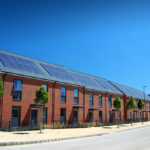The UK’s net zero strategy that includes ambitious carbon reduction targets in both the new Part L and the Future Homes Standard, as well as the recent announcement of the Government’s Heat and Buildings Strategy, and the associated £800m Social Housing Decarbonisation Fund, means the spotlight is on those responsible for ensuring improved energy performance in the nation’s homes, discusses Stuart Nicholson, Roof Systems Director at Marley.
Targets are clear. All new homes are expected to produce 31% lower carbon emissions from 2022 as part of changes to Part L of the Building Regulations. Playing a significant role in delivering a more sustainable future will be the decisions made by local authorities and social housing providers by incorporating energy saving technologies into new properties and refurbishment projects. The current energy cost crisis, with further hikes predicted in 2022, also emphasises the urgent need to provide income-poor tenants with access to alternative and cheaper heat and power.
Improvements in energy efficiency cannot purely be made through simple changes to the building fabric, it also requires a step change in the specification of available technology.
For local authorities and social housing providers, a clear specification pathway can assist in the urgent energy transformation of the homes they are responsible for. With looming deadlines, in the short-term, the selection of solar PV solutions on the roof, combined with an efficient gas boiler appears to be the easiest and most cost-effective way to meet the new Part L targets, partially because supply chains are ready and trusted installers are in place. PV technology is tried and tested, readily available, and has become much more affordable over recent times.
Looking into the future however, under the Future Homes Standard, it is anticipated all new homes will have heat pumps as the primary heating system. But this will need to go together with greater uptake of solar PV solutions to ensure running costs are kept under control.

Energy benefits within a low carbon energy mix
The role of solar PV as an integrated part of an energy-efficient performance mix within homes is growing in importance. Its rise in popularity is evidenced by the 27% year-on-year increase seen in new solar capacity as reported by Solar Energy UK in 2020 — with 40% of the increase directly resulting from installations in homes and commercial buildings.
Alongside popularity, factors such as improved aesthetics, affordability, quick installation times and proven performance, are also helping to make the case for solar PV as a strategically important element of the home energy efficiency revolution. Depending on available roof space and the household electricity usage, a well-sized PV solar energy system can cover a significant portion of a home or building’s annual electricity usage — up to 65-75% in many cases. When used in combination with battery storage, solar PV also enhances energy cost efficiencies. By storing excess solar energy from the PV system for nighttime usage, it can help tenants make savings on electricity bills.
Other good ways of helping energy affordability for tenants is the use of power diverters within systems. They work by using the surplus solar energy the installed PV system generates and instead of letting it go back to the grid, simply redirects it to cost effectively heat a household’s water tank for example.
Finally, when it comes to providing the most effective use of solar PV and heat pumps post 2025 when gas fired boilers are excluded from new-builds, it is critical properties are insulated to a high standard. If they are not, this will increase the heat demand within the home, leading to increased electricity pressures to generate heat. The more heat or warmth preserved by the property’s insulation, the greater the reduction of the running cost of heat pumps as they work less intensively.

Aesthetics and performance
Advances in solar PV technology mean there are now many more design-led options available, and at a much more affordable price which can better suit local authority and social housing budgets. When it comes to solar PV, there are three options to choose from: a traditional on-roof panel, or two different types of integrated PV system (one with a separate tray and one with an integrated tray).
Many people associate solar panels with the original on-roof systems, which consist of a set of panels attached to the rafters by a mount, sitting over the top of the roof tiles. These can stand out too much, so modern, integrated solar PV systems have been developed, which blend in seamlessly with roofscapes. These roof-integrated panels incorporate into the roof surface, acting as an MCS 012 approved building material, effectively replacing a section of tiles.
There is a belief that on-roof systems generate more electricity. However, the difference is relatively small and is outweighed by some of the other disadvantages of an on-roof system, particularly because they can look quite bulky.
Modern on-roof panels are sleeker than in the past, but they hold no comparison to the aesthetic of roof integrated PV. As both tiles and PV are installed together, it means there is no modification to the roof tiles, securing the warranty. Marley’s SolarTile system is compatible with all the manufacturer’s clay and concrete tiles, allowing the easy incorporation of solar PV into any roof design.
Catalyst for change
The recently announced Social Housing Decarbonisation Fund, available for use by social landlords, including housing associations, to carry out energy efficiency technology upgrades in their tenants’ homes is an important step forward.
It should now act as the catalyst for change and help to kick-start tangible efforts to ensure social housing stock is made as energy-efficient as possible.









